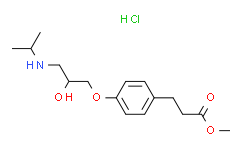| 中文名称: | 盐酸艾司洛尔 促销 | ||||
|---|---|---|---|---|---|
| 英文名称: | Esmolol hydrochloride | ||||
| 别名: | 盐酸艾司洛尔 Esmolol hydrochloride | ||||
| CAS No: | 81161-17-3 | 分子式: | C16H26ClNO4 | 分子量: | 331.83 |
| CAS No: | 81161-17-3 | ||||
| 分子式: | C16H26ClNO4 | ||||
| 分子量: | 331.83 | ||||
| EINEC: | 6530 | ||||
| EINEC: | 6530 | ||||
基本信息
|
产品编号:E10374 |
|||||
|
产品名称:Esmolol hydrochloride |
|||||
|
CAS: |
81161-17-3 |
储存条件 |
粉末 |
2-8℃ |
四年 |
|
|
|
||||
|
分子式: |
溶于液体 |
-80℃ |
六个月 |
||
|
分子量 |
331.83 |
-20℃ |
一个月 |
||
|
化学名: |
methyl 3-[4-[2-hydroxy-3-(propan-2-ylamino)propoxy]phenyl]propanoate;hydrochloride |
||||
|
Solubility (25°C) |
体外 |
DMSO |
≥100mg/mL (301.36mM) |
||
|
Ethanol |
≥50mg/mL (150.68mM) |
||||
|
Water |
Insoluble |
||||
|
体内 |
现配现用 |
|
|||
|
<1mg/ml表示微溶或不溶。 |
|||||
|
普西唐提供的所有化合物浓度为内部测试所得,实际溶液度可能与公布值有所偏差,属于正常的批间细微差异现象。 |
|||||
|
请根据产品在不同溶剂中的溶解度选择合适的溶剂配制储备液;⼀旦配成溶液,请分装保存,避免反复冻融造成的产品失效。 |
|||||
制备储备液
|
浓度
溶液体积 质量 |
1mg |
5mg |
10mg |
|
1mM |
3.0136mL |
15.0680mL |
30.1359mL |
|
5mM |
0.6027mL |
3.0136mL |
6.0272mL |
|
10mM |
0.3014mL |
1.5068mL |
3.0136mL |
生物活性
|
产品描述 |
一种 β 肾上腺素受体抑制剂。 |
|
靶点/IC50 |
Adrenergic receptor |
|
体外研究 |
Esmolol hydrochloride is the hydrochloride salt form of Esmolol, a short and rapid-acting beta adrenergic antagonist belonging to the class II anti-arrhythmic drugs and devoid of intrinsic sympathomimetic activity. Esmolol hydrochloride competitively blocks beta-1 adrenergic receptors in cardiac muscle and reduces the contractility and cardiac rate of heart muscle, thereby decreasing cardiac output and myocardial oxygen demands. This agent also decreases sympathetic output centrally and blocks renin secretion. At higher doses, Esmolol hydrochloride also blocks beta-2 receptors located in bronchial and vascular smooth muscle, thereby leading to smooth muscle relaxation. |
本计算器可帮助您计算出特定溶液中溶质的质量、溶液浓度和体积之间的关系,公式为:
质量 (g) = 浓度 (mol/L) x 体积 (L) x 分子量 (g/mol)
摩尔浓度计算公式
用本工具协助配置特定浓度的溶液,使用的计算公式为:
开始浓度 x 开始体积 = 最终浓度 x 最终体积
稀释公式
稀释公式一般简略地表示为:C1V1 = C2V2 ( 输入 输出 )








